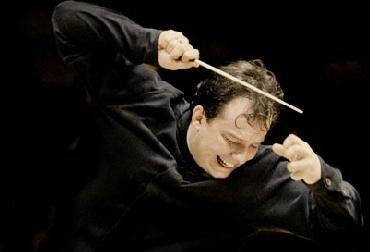by Paul J. Pelkonen

Andris Nelsons. Photo by Marco Borggreve © 2012 AndrisNelsons.com
Before delving into today's review of the New York Philharmonic's concert of Thursday, February 7th, let us take a moment to consider...the oboe.
On Thursday night, New York Philharmonic principal oboist Liang Wang played a key role in all three works on the program. The concert, conducted by Latvian maestro Andris Nelsons, featured three works: Antonín Dvořák's orchestral fairy tale The Noon-Day Witch, Johannes Brahms' Violin Concerto, and finally Béla Bartók's Concerto for Orchestra which gave Mr. Wang and most of his fellow musicians a turn in the limelight.
The program opened with the Dvořák, a work added to the orchestra's repertory by music director Alan Gilbert in 2011. Mr. Nelsons conducted with broad, bold strokes, capturing the rustic spirit of this music without resorting to vulgarity. Mr. Wang represented the playful voice of the child whose mischief comes to a terrible mortal end at the hands of the titular witch. Powerful playing from the brass marked the child's end, and the work was spurred to a massive rhythmic climax.
Christian Tetzlaff joined the orchestra for the Brahms Violin Concerto. The veteran virtuoso drew applause after the marathon first movement, alternating the main theme with the orchestra and drawing soulful cries from his instrument. Whether drawing out the solo version of the main theme or interacting with Mr. Nelsons' robust conducting, this was a bold performance that matched passion with intellect.
When Brahms published this concerto, the second movement drew criticism from the violinist Pablo de Sarasate. In fact, Sarasate refused to play it, on the grounds that he did not want to play second fiddle to the woodwind. Here, Mr. Wang who iterated this main theme with sweet, plangent tone, before Mr. Tetzlaff echoed it and reflected on the melody with his solo instrument. The final Allegro giocoso pleased listeners with big-hearted, muscular playing from Mr. Tetzlaff, expertly answered in tutti by the orchestra.
Even the most jaded concert-goer, steeled against any music more modern than Stravinsky's Rite of Spring likes Bartók's Concerto for Orchestra. Members of the orchestra like it too, as this complex five-movement structure it allows every section or soloist a turn to show their stuff.
Mr. Nelsons played the outer movements with grave seriousness of purpose, which made the merry contrast of the Allegretto (second) and the Interrupted Intermezzo (with its blast of clarinet and brass rudely echoing Shostakovich's Leningrad Symphony) stand out all the more. The central slow movement featured more elegaic playing from Mr. Wang, confirming his central part as one of the Philharmonic's finest players.

